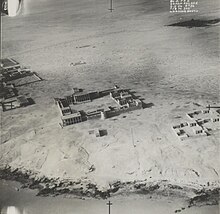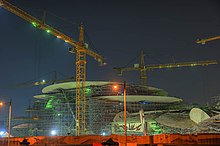art.wikisort.org - Museum
The National Museum of Qatar is a national museum in Doha, Qatar. The current building opened to the public on 28 March 2019, replacing the previous building which opened in 1975. The building was designed by architect Jean Nouvel who was inspired by the desert rose crystal, which can be found in Qatar.[1][2] The museum site includes Sheikh Abdullah bin Jassim Al Thani's Palace, which is the heart of the Qatari national identity.[3] As of 2013, the director of the museum is Sheikha Amna.[4]
 View of the National Museum of Qatar from the beach, in 2020 | |
 | |
| Established | Opened 28 March 2019 |
|---|---|
| Location | Doha, Qatar |
| Coordinates | 25.2879°N 51.5494°E |
| Type | Museum |
| Director | Sheikha Amna bint Abdulaziz bin Jassim Al Thani |
| Owner | Qatar Museums |
| Website | nmoq |
Collection

A tour of the museum takes visitors through a loop of galleries that address three major, interrelated themes. The galleries are loosely arranged in chronological order, beginning with exhibitions on the natural history of the desert and the Persian Gulf, artefacts from Bedouin culture, historical exhibitions on the tribal wars, the establishment of the Qatari state, and finally the discovery of oil to the present.[5] The displays and installations that explore these themes present audiovisual displays with carefully selected treasures from the museum's collections. These collections currently consist of approximately 8,000 objects and include archaeological artefacts, architectural elements, heritage household and travelling objects, textiles and costumes, jewelry, decorative arts, books, and historical documents.[6]
The museum's mission is to celebrate the culture, heritage, and future of Qatar and its people, embodying the pride and traditions of Qataris while offering international visitors a dialogue about rapid change and modernization.[7]
Since its inauguration, the museum contained materials which signify Qatar's cultural heritage, such as Bedouin ethnographic materials, maritime artifacts and environmental items. Ancient artifacts, most of which are locally derived, are also housed in the museum.[8]
Archaeological artifacts
British archaeologist Beatrice de Cardi and her team were commissioned to undertake expeditions in Qatar from November 1973 to January 1974 in order to collect artifacts to display in the museum.[9] Their most significant discoveries were at the site of Al Da'asa, which contained numerous Ubaid potsherds dating to the Neolithic period.[10] Artifacts from the earlier Danish expeditions launched throughout the 1950s and 1960s, previously housed at the Doha Public Library,[11] were also put on display in the museum.[8]
The museum's antiquities department had an active role in surveys and excavations after De Cardi's expedition ended. They excavated the archaeological sites of Al Wusail and Zubarah.[12]
Ethnographic materials
Materials documenting Bedouin ethnography range widely in theme. Certain objects on display were historically used as tools and weapons by the Bedouin, whereas others are products such as jewellery, pottery and costumes. Traditional poems are featured in the museum; most notable are works composed by Qatari ibn al-Fuja'a and former emir Jassim bin Mohammed Al Thani.[13]
In 2015, Sheikh Mubarak bin Saif Al Thani presented the first written draft of the anthem to the Qatar National Museum to be put on display. It was originally scheduled to be moved to the new museum upon its completion.[14]
History

Upon Khalifa bin Hamad Al Thani's accession to the throne in 1972, he drew up plans for a national museum in order to document the country's heritage and traditions. That year, he contracted Michael Rice & Company to design the structural and functional aspects of the museum. It was decided that the building would enclose the Old Amiri Palace, a dilapidated early-20th century palace previously occupied by Qatar's former emir, Abdullah bin Jassim Al Thani.[15] A lagoon was also created to provide a venue for showcasing traditional dhows and pearling equipment.[13]

Originally named the Qatar National Museum, it was inaugurated on 23 June 1975.[16] Originally, its facilities included a 100-seat auditorium and a library.[13] In 1980, the museum was awarded the Aga Khan Award for Architecture.[17] The royal palace which the museum was built around was refurbished in 2015 in preparation for the opening of the new museum.[18]
New building
The new building was constructed on the site of the old building. It was designed by Pritzker Prize-winning architect Jean Nouvel who was inspired by the desert rose and grows around the original twentieth century palace of Sheikh Abdullah bin Jassim Al Thani.[19] The historic palace was restored by Berlin-based architecture and engineering firm ZRS Architekten Ingenieure.[20] This important monument to Qatar's past is now preserved as the heart of the new NMoQ.[21] The relation between the new building and the old building is part of creating the bridge between the past and the present advocated by Sheikha Al Mayassa as a way to "define ourselves instead of forever being defined by others […]" and of "celebrating our identity".[22]
The 430,000 square foot (40,000 m2) museum is made up of interlocking discs that create cavities to protect visitors from the desert heat.[23] Located on a 1.5 million ft² site at the south end of Doha's Corniche,[24] the NMoQ building rises from the sea and is connected to the shore by two pedestrian bridges and a road bridge.[24]

Originally, the museum was scheduled to open in 2016,[25] but its opening was pushed back to 28 March 2019.[26][27] Time magazine named it one of the World's Greatest Places to Visit in 2019, citing the integration of "immersive video screens and dioramas" into Jean Nouvel's architectural design.[28][29]
The museum welcomed more than 450,000 visitors in less than a year of its opening.[30] The museum attracts people as it depicts Qatar's history not through paintings and sculptures but with 21st-century lights, sounds and visuals.[31]
Contractor
The main building was contracted to a Korea-based company; Hyundai Engineering & Construction in 2011.[32] The project involved the construction of the new National Museum next to the existing Qatar National Museum, which is located across from the Doha Corniche. The museum is designed according to the Bedouin tradition of Qatar.[33] It includes a building in the shape of a desert rose and a 1.2 million ft² landscaped park. The project also includes a 115,000 m2 park with an artificial lagoon and parking spaces for 400 vehicles, a 220-seat auditorium, a research center, laboratories, a dedicated food forum, two restaurants, a café, and two museum shops, one for children.[34]
Exhibitions
- "Pipilotti Rist: Your Brain to Me, My Brain to You",Curated by Tom Eccles and Bouthayna Baltaj, March 2022 to January 2023.[35][36]
- "A Sneak Peek at Qatar Auto Museum Project", March 2022 to January 2023.[37]
See also
- List of museums in Qatar
- Qatar Museums
- Culture of Qatar
References
- Powell, Jim (30 March 2019). "The 20 photographs of the week". The Guardian. Retrieved 3 April 2019.
- "National Museum of Qatar". Ateliers Jean Nouvel. Retrieved 2 June 2022.
- "Spectacular Jean Nouvel Designed National Museum Qatar To Open In March". Artlyst. Retrieved 16 November 2021.
- "Sheikha Amna to head new museum". Gulf-Times (in Arabic). 27 November 2013. Retrieved 12 April 2021.
- Celebrating the Delicate Beauty of the Desert Landscape by NICOLAI OUROUSSOFF in The New York Times, 22 March 2010
- Qatar Museums Authority Unveils Jean Nouvel Design for New Museum in the ArtDaily
- New Qatar National Museum…a journey in a world of fantasy!
- Karen Exell; Trinidad Rico (2013). "'There is no heritage in Qatar': Orientalism, colonialism and other problematic histories" (PDF). World Archaeology. 45 (4): 670–685. doi:10.1080/00438243.2013.852069.
- "Beatrice de Cardi obituary". the Guardian. 14 July 2016. Retrieved 2 June 2022.
- M. Abdul Nayeem (1998), p. 36
- "The era of reform". HathiTrust. New York: Permanent Mission of the State of Qatar to the United Nation. 1973. p. 33.
- M. Abdul Nayeem (1998), p. 39
- Rice, Michael (1977). "National museum of Doha, Qatar" (PDF). Museum. XXIX (2/3): 78–87. Retrieved 18 December 2015.
- "Poet's donation shines spotlight on origins of Qatar's national anthem". Doha News. 28 November 2015. Archived from the original on 8 December 2015. Retrieved 22 February 2016.
- "Wherefore Art Thou Qatar?". The Business Year. 2014. Retrieved 25 February 2016.
- Mohammed Hassan Al-Kuwari; Maryam Khulaifi; Jamila Abdulla Ahmed; Sawsan Al-Haddad (2013). "دليـل المؤسسات الثقافية في قطر (Directory of Cultural Institutions in Qatar)" (PDF) (in Arabic). Ministry of Culture, Arts and Heritage. p. 12. Archived from the original (PDF) on 22 December 2015.
- "National Museum". Aga Khan Development Network. Archived from the original on 4 March 2016. Retrieved 18 December 2015.
- Lesley Walker (21 June 2015). "Sheikh Abdullah's palace at heart of National Museum of Qatar restored". Doha News. Archived from the original on 22 December 2015. Retrieved 18 December 2015.
- "National Museum of Qatar". Ateliers Jean Nouvel. Retrieved 8 June 2022.
- "ZRS". Retrieved 2 June 2022.
- National Museum of Qatar Archived 2013-05-12 at the Wayback Machine
- Hanley, D.C. "A Desert Rose takes shape: plans for National Museum of Qatar Unveiled". Washington Report on Middle East Affairs. 4. 29: 32–33.
- Take a first look at the upcoming Qatar National Museum, 28 July 2011
- "A Rose in the Desert: Jean Nouvel's National Museum of Qatar Debuts". SURFACE. 28 March 2019. Retrieved 16 November 2021.
- Shabina S. Khatri (6 July 2014). "Qatar's National Museum eyeing 2016 opening". Doha News. Archived from the original on 28 March 2019. Retrieved 2 June 2015.
- "Qatar's national museum by Jean Nouvel opening date announced". Gulf Times Qatar. 4 November 2018. Retrieved 4 November 2018.
- Joanne Martin (28 March 2019). "The Middle East's hottest new museum is here". CNN. Retrieved 12 August 2019.
- "The National Museum of Qatar". Time Magazine. USA. 22 August 2019. Retrieved 29 August 2019.
- "National Museum of Qatar announced as one of the World's Greatest Places!". iLoveQatar.net. Qatar: Haroon United Group. 24 August 2019. Retrieved 29 August 2019.
- Belcher, David (7 January 2020). "Opinion | Skip the Vatican Museum. Go to the National Museum of Qatar". The New York Times. ISSN 0362-4331. Retrieved 8 June 2022.
- Belcher, David (7 January 2020). "Skip the Vatican Museum. Go to the National Museum of Qatar". The New York Times. Retrieved 7 January 2020.
- "Hyundai E&C".
- "Project – National Museum of Qatar | ERCO". www.erco.com. Retrieved 8 June 2022.
- "National Museum of Qatar to join forces with Microsoft to accelerate Qatar Museums digital transformation". www.zawya.com. Retrieved 16 November 2021.
- "Pipilotti Rist: Your Brain to Me, My Brain to You". NMOQ. Retrieved 3 June 2022.
- "National Museum of Qatar unveils Pipilotti Rist's Your Brain to Me, My Brain to You installation". artdaily.com. Retrieved 3 June 2022.
- "A Sneak Peek at Qatar Auto Museum Project". NMOQ. Retrieved 3 June 2022.
Bibliography
- Abdul Nayeem, Muhammad (1998). Qatar Prehistory and Protohistory from the Most Ancient Times (Ca. 1,000,000 to End of B.C. Era). Hyderabad Publishers. ISBN 9788185492049.
External links
Другой контент может иметь иную лицензию. Перед использованием материалов сайта WikiSort.org внимательно изучите правила лицензирования конкретных элементов наполнения сайта.
WikiSort.org - проект по пересортировке и дополнению контента Википедии